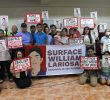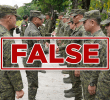TAGUM CITY – “Day of mourning.”
This was a description given by the country’s media watchdog in the observance of the World Press Freedom Day 2014 in the Philippines last May 3 in remembering journalists who have died or have faced threats of incarceration.
“WORLD PRESS Freedom Day has for many years been an occasion for mourning rather than celebration in the Philippines, where, since 1986, 140 journalists and media workers have been killed for their work, among them the 32 killed on November 23, 2009 in Ampatuan town, Maguindanao province. This year’s commemoration is no different,” the Center for Media Freedom and Responsibility (CMFR) said in a statement Friday.
The Davao del Norte TV and Radio Press Club here said “the reports only confirm the idle response of the Aquino government to resolve the media killings and threats.”
CMFR said that killings have not ceased since President Aquino III took office in 2010, citing that 22 have been killed in the line of duty. Fourteen journalists/media workers were killed in 2013, with 10 killed in the line of duty.
When asked by a US-based reporter regarding the country’s journalist killings during the state visit of US Pres. Barack Obama last week, Pres. Aquino was quick to downplay the media killings and earned media criticism when he erred in citing the actual number of journalists killed in the infamous Maguindanao massacre.
The local media watchdog said “the highest number of work-related killings is year 2009, when 37 journalists/media workers were killed.”
The latest victim in the rising death statistics was Robelita “Ruby” Garcia, a reporter for Remate tabloid. Garcia, the first victim this year, was shot to death by an unknown assailant in her home in Bacoor City, Cavite last April 6.
One hundred and forty (140) journalists/media workers have been killed in the line of duty since 1986, when the institutions of liberal democracy were restored in the Philippines, the CMFR said.
CMFR reported that “attacks and threats against journalists increased compared to previous years. The cases of journalist killings also continued to languish in the courts.”
“Only 13 cases that reached the courts have resulted in the conviction of the killers. Only the gunmen and their accomplices have been found guilty. No mastermind has been convicted,” the group said.
CMFR has also recorded 68 incidents of attacks and threats against journalists and media workers in 2013, saying “25 of these incidents, as in the Ampatuan Massacre, were related to media’s coverage of the elections.”
In a phone interview, CMFR’s Deputy Director Luis Teodoro told DavaoToday that “CMFR has asked the Aquino government to address the slow progress of the trials of the killers of the journalist.”
When asked as to how the culture of impunity, threats and abuses against media workers will be stopped, Teodoro suggested that a “multi-sectoral quick response team should be created to investigate when a journalist is killed.”
“An enhanced police forensics capability and increase support for the Witness Protection Program (WPP) will also contribute a significant development to address the issues,” said Teodoro.
Teodoro added: “(T)he Aquino government has only increased the WPP budget but created a mostly ineffective inter-agency committee.”
A Bangkok-based media watchdog campaigning for genuine press freedom in Southeast Asia, reported that journalists covering national elections “echo the challenges faced by media in elections where the added pressure of raised political stakes also increase the challenge of independence, safety risks, and ethical issues of the profession.
Journalistic skills are also put to the test, raising the need for more training on election coverage.”
The Southeast Asian Press Alliance (SEAPA) said that “national elections provide a common context of key developments on media freedom situation in six countries in Southeast Asia countries this year.”
In the Philippines, the infamous “Maguindanao Massacre” claimed the lives of thirty-two (32) journalists in which 58 people were killed on November 23, 2009 in a single incident of election-related violence in Ampatuan town, Maguindanao province.
Aside from the media killings, SEAPA noted that Southeast Asian governments are falling in line to put regulations over online media and expression including the Philippines.
The Supreme Court finally ruled on the constitutionality of the law of the Cybercrime Prevention Act and struck down several provisions including those allowing government to block websites and collect metadata.
Media groups and free advocates strongly criticized the court for finding as constitutional the crime of online libel.
“Those with restricted media environments remain unchanged as their politics. There may be little overt censorship reported because control has been institutionalized through self-censorship by media houses or individual journalists who do not wish to risk their professions, safety or freedom.”
SEAPA concluded “the media situation in Southeast Asia remains largely where it is: countries with relatively freer media remain beset with the problems of impunity for violence and politics-related control through threats and lawsuits.”
Another media watchdog that promotes and defends freedom of information and freedom of the press, ranked Philippines as 129th out of 180 countries based on The 2014 World Press Freedom Index.
France-based Reporters Without Borders Head of Research Luci Morillon, said, the ranking of some countries, including democracies, has been impacted by an overly broad and abusive interpretation of the concept of national security protection.
The report said “the 2014 index emphasizes the negative correlation between armed conflicts and freedom of information. “In an unstable environment, the media become strategic goals or targets for groups or individuals trying to control news and information in violation of the guarantees enshrined in international conventions.”
In 2013, Philippines landed on the 147th spot and in the 140th in 2011-2012 and in 2010, the country ranked at 156th place after the Maguindanao massacre. The Philippines ranked 122nd in 2009, press freedom index.
According to Reporters Without Borders, more than a third of the world’s population live in countries where there is no press freedom or where there is no system of democracy or where there are serious deficiencies in the democratic process.
While the Committee to Protect Journalists, the Philippines ranks third after Iraq and Somalia among countries where journalists’ murders are unpunished, based on the Global Impunity Index released by the Committee to Protect Journalists last April.
Article 19 of the 1948 Universal Declaration on Human Rights (considered as an important stepping stone to the freedom of press) states that everyone “has the right to freedom of opinion and expression, this right includes freedom to hold opinions without interference and to see, receive and impart information and ideas through any media and regardless of frontiers.”
“We don’t think the killings will stop unless the Aquino government takes necessary steps to punish the killers and masterminds.” Teodoro said.
The World Press Freedom Day was established by the General Assembly of the United Nations in December 1993 as an outgrowth of the ‘Windhoek Declaration’ adopted in 1991 in Namibia for promoting independent and the need of a free press for developing and maintaining democracy and for economic development.(Mart D. Sambalud/davaotoday.com)










